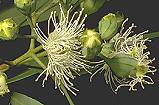This was the way things stood until the February 2000 when a paper by Ian Brooker appeared. Again to oversimplify, he wrote that he thought the some of the characters used to say that Angophora and Corymbia were closely related were pretty dicey. Nor was he impressed with some of the DNA sequencing. One of the points he made was that few botanists used one of the techniques and suggested that this indicated it was a poor one. Furthermore, in his opinion, the ghost gums should not be combined with the bloodwoods. Nevertheless, he thought that Angophora was so close to Eucalyptus that they should be in the one genus. Fortunately Eucalyptus was named in 1789 and Angophora in 1797 so Eucalyptus has precedence. Brooker then presents a new classification which is broadly arranged from primitive (sub-genus Angophora) up to the more advanced sub-genera. But he didn't draw a "tree" to show the relationships he envisioned. In the course of his work he allocates Eucalyptus names to the 33 Corymbia of Hill and Johnson and also new names to those angophoras whose names were already occupied by Eucalyptus species. According to this scheme there is only one genus: Eucalyptus; and there are now valid, published names for all of them. So it's all very clear and simple now isn't it? Well, no it isn't. In the same issue as Ian Brooker's paper, there is another paper by the Melbourne DNA workers, Pauline Ladriges and Frank Udovicic. To put it mildly, they reject Brooker's scheme and re-assert the Hill and Johnson one. They are certainly forthright in their opinions. For example, in reply to Brooker's argument that few botanists use one of their techniques they quote someone called Butler: "things determined by the most Voyces are not the greatest Truths but Noyses." In reply to Brooker's statement that he is not convinced bloodwoods and ghost gums can be combined they wrote: "Nor is there reason to believe that he would be convinced by further evidence? no matter the quantity". So what should you do? You are free to make your own choice. You can validly refer to all "eucalypts" as Eucalyptus, quoting Brooker if challenged, or you can split them up into the three genera. But how to choose? I suggest that it depends on whether you are a fundamentalist or a pragmatist.
Fundamentalists argue that classification must follow evolution. If the branching structures created by computer programs show one group branching off and then another group branching from this, this must be reflected in the names given to the groups. The figure shows the branchings generated by the Melbourne workers for the eucalypts. It shows Angophora, Corymbia and Blakella separating early from the rest of the eucalypts. They say: "Our rejection of Brooker's (scheme) is not a quibble with rank (genus versus subgenus) but a matter of evidence." You may now see why I have chosen the sobriquet "fundamentalist". Pragmatists say that classifications are generated by humans for our convenience and a genus is a grouping of questionable natural significance. They point out that apples and pears, though very similar are placed in different genera for culinary reasons, and that tomatoes, though obviously solanums are given their special genus. That is, there is precedence for using "custom" or what might be called emotional grounds for specifying a genus. They argue that formation of hybrids and their progeny can mean that the branching diagrams may have crossed limbs. They criticise the computer modellers for using only a small proportion of the species and not seeing the whole picture and so not realising that a characteristic used to distinguish some pairs also occurs in widely different groups - and so is not really diagnostic. They may reject the idea that classification must mirror evolution, or they may argue that the computer generated trees don't necessarily reflect evolution.  This figure is simplified from the paper by Ladriges and Udovicic. It shows Angophora and Corymbia/Blakella branching off from the rest of the eucalypts. In the Brooker scheme, all of these branches are combined into one tree and all are called Eucalyptus. Brooker also says that Corymbia (bloodwoods) and Blakella (ghost gums) are not so closely related. So are the pragmatists Luddites refusing to accept new techniques, heathens refusing to accept the new gospel, or are they sensible well balanced people looking at the whole picture?.........You decide! A footnote. Everyone knows that Eucalyptus means "well covered" and refers to the bud cap. So can a plant that does not have a bud cap but rather petals (ie Angophora) be a Eucalyptus? Of course it can. The name isn't the prescription. If it were, all melaleucas would have a black (melas) trunk and white (leucos) branches. Second footnote. I've looked in every book of quotations for the "Butler" who said everyone else is out of step, but can't find it anywhere. ReferencesJust in case you want to look at the original papers, here are the references.
From the newsletter of the Wildflower Society of Western Australia, May 2000.  [Front Page] [Features] [Departments] [Society Home] [Subscribe] Australian Plants online - September 2000 |



